Chapter 18.70
DESIGN STANDARDS AND REQUIREMENTS
Sections:
18.70.015 Design review and deviation.
18.70.030 Site design standards and requirements.
18.70.035 Building design standards and requirements.
18.70.040 Auto-related business design standards.
18.70.070 Neighborhood Business incentives.
18.70.010 Purpose.
A. The City of Maple Valley has developed design standards and requirements in the interest of those who live, work, shop or recreate here. The City and those who develop in the City have a common interest in assuring quality development that benefits property owners and the City.
B. The City incorporates design review procedures that:
1. Apply to designated Commercial, Town Center, and Multiple-Family areas of the City and to nonresidential buildings throughout the City;
2. Allow for flexibility to accommodate creative design; and
3. Encourage a design review process that can be integrated into an applicant’s site design for economy of design resources.
C. The City is committed to creating walkable and interesting shopping districts separated by arterial street buffers, and connected by pedestrian ways and the Lake Wilderness trail.
D. The following procedures are intended to accomplish the objectives above. The underlying premise of the procedures established for design review is to provide City review that parallels or is integrated with an applicant’s site and building design development. The developer has access to the resources of the Department in interpreting and applying the standards and requirements as development design progresses so that design resources are directed to known, expected results.
E. Where there is a conflict between this chapter and other Maple Valley regulations not associated with the adopted State Building Code, the provisions contained within this chapter shall govern where applicable. Should there be a question regarding the interpretation of these codes the Director shall be authorized to make an official code interpretation.
F. Many of the optional implementation measures discussed in the City of Maple Valley design standards appear several times throughout the document. Any implementing measure that appears as an option may be used more than once only if the design and quality would be substantially enhanced. (Ord. O-16-598 § 1(B) (Exh. B); Ord. O-11-442 § 1; Ord. O-05-304 § 4).
18.70.015 Design review and deviation.
A. All decisions on design review shall be made through the design review process (MVMC 18.110.020).
B. All deviations from design review proposed in order to produce a better result shall be made through the design deviation process (MVMC 18.110.025). (Ord. O-16-598 § 1(B) (Exh. B); Ord. O-05-304 § 4).
18.70.020 Applicability.
A. The design standards shall be implemented in the following manner:
1. The design standards shall apply to all new construction in CB, NB, R-12, R-18, R-24, TC, RLTC and REC zones; they shall also apply to nonresidential buildings in all zones throughout the City; they shall also apply in the R-8 zone for townhouse developments with a total of five or more dwelling units in one or more structures; they shall also apply in the PRO, R-1, R-4, and R-6 zones, but only to nonresidential structures.
a. Publicly owned buildings and structures used for public purposes do not trigger the requirements of this section when all of the following criteria are met:
i. The building or structure is no more than 2,000 square feet in total size;
ii. The building or structure is a single story and does not exceed a height of more than 20 feet;
iii. The building or structure is visually obstructed by existing or proposed screening, buildings, vegetation or distance from adjacent sites, streets and the public right-of-way; and
iv. The building or structure complies with all other necessary requirements of the development regulations and building codes.
b. The Department of Community Development shall have the authority to approve, approve with conditions, or deny an exemption from the requirements of this section as a Process 1 decision for buildings and structures not used for commercial purposes within the PUB and PRO zones, such as bus stops, picnic shelters, storage buildings, restroom facilities, and similar buildings, and structures within designated community recreation areas. An exemption may be granted only when all the following criteria are met:
i. The building or structure is no more than 400 square feet;
ii. The building or structure is a single story no more than 20 feet in height;
iii. The building or structure is visually obstructed by existing or proposed screening, buildings, vegetation or distance from adjacent sites, streets and the public right-of-way; and
iv. The building or structure complies with all other necessary requirements of the development regulations and building codes.
2. For all existing structures in the zones as noted in subsection (A)(1) of this section with exterior improvements/additions less than 50 percent of the replacement value of the structure, then only that applicable portion of the structure and associated site improvements shall comply.
3. For all existing structures in the zones as noted in subsection (A)(1) of this section with exterior remodels greater than 50 percent of the replacement value of the structure in any three-year period, then the standards apply to the entire structure and associated site improvements.
B. Interior remodeling or interior tenant improvements do not trigger the requirements of this section. Only those improvements to the exterior of an existing structure, including exterior mounted mechanical equipment, must meet applicable design standards and requirements.
C. Structures located within the Downtown Overlay District (Ordinance No. O-23-781, Exh. C) are subject to the Downtown Design Standards and Guidelines and the Downtown Public Realm Design Concept contained in Ordinance No. O-23-781, as that ordinance may be amended from time to time. To the extent that any conflict exists between Ordinance No. O-23-781 and this code, Ordinance No. O-23-781 shall control. (Ord. O-23-781 § 4 (Exh. D); Ord. O-16-598 § 1(B) (Exh. B); Ord. O-12-499 § 10; Ord. O-12-492 § 7; Ord. O-12-490 § 10; Ord. O-11-442 § 2; Ord. O-09-393 § 1; Ord. O-05-304 § 4).
18.70.030 Site design standards and requirements.
A. Site Planning – Connectivity.
1. Goal. Provide safe and efficient pedestrian and vehicular connections to existing neighborhoods, commercial areas, public services, and transit. Discourage new development that precludes the opportunity to provide future pedestrian and vehicular connections.
2. Standards and Requirements.
a. Wherever possible, developments shall provide interior automobile and pedestrian connections to adjacent properties through the development of appropriate street frontage and use of cross access easements, common driveways, shared internal roadways and parking lots, and similar techniques. Where connections are not possible, site design shall not preclude possible future connections.
b. Where the adjacent property is vacant or developed and does not provide adequate connections, the configuration and layout of the proposed development shall provide the opportunity for future connections to the satisfaction of the Director.
c. Where demonstrated that vehicular and/or pedestrian connections between adjacent properties are impractical (such as: topography, environmental, or unusual lot configuration), unnecessary or undesirable (such as where uses are not compatible), developments shall provide at least 10 feet of Type III landscaping, as defined in MVMC 18.40.130, along the applicable side where no vehicular and/or pedestrian connections are provided; provided, that if the applicable side borders or includes a transmission line power easement, such landscaping shall not be required.
d. Where abutting developed land provides road stub-outs, easements, or other methods to provide the opportunity for future road connections, the interior network of new development shall be designed to utilize these connections.
e. Avoid dead-end streets to the extent possible.
B. Site Planning – Building/Sidewalk Relationship.
1. Goal. Provide for interesting and walkable streets, provide attractive building facades, reduce the impact of large parking lots on the streetscape, enhance the overall design and layout of developments, retain and enhance the wooded character of Maple Valley.
2. Standards and Requirements.
a. Provide an appropriate building/sidewalk relationship based on the combination of zoning and the classification of street or streets fronting on the property.
b. To qualify as a “pedestrian-oriented building facade,” the following conditions must be met:
i. Transparent window area or window displays along a minimum of 75 percent of the ground floor facade between a height of two feet to eight feet above the ground;
ii. A building entry must be facing the street; and
iii. Weather protection at least four and one-half feet wide along at least 75 percent of the facade width.
Figure 1. Illustrating the minimum requirements for pedestrian-oriented facades.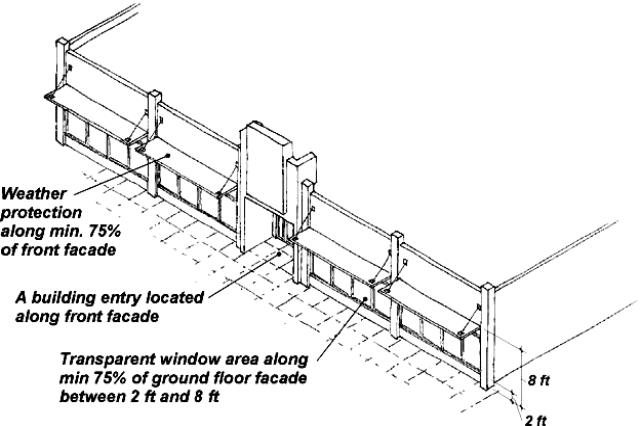
c. Table 1 shows the street classification system by zoning and applies the building/sidewalk relationship that must be constructed in the various situations.
|
|
Street Classification |
|||
|---|---|---|---|---|
|
Applicable Zone |
ARTERIAL STREETS(1) |
BUSINESS COLLECTOR STREETS(1) |
LOCAL ACCESS STREETS(1) |
TWO OR MORE DIFFERENT STREET CLASSIFICATIONS(1) |
|
CB/NB/TC/ |
Pedestrian-oriented building facade in CB and TC Zones is required(2) Or for all other listed zones: 20-foot landscape buffer(3) if more than 2 rows parking Or 10-foot buffer with Type III landscaping(4) if nonpedestrian-oriented building facade or 2 rows or less of parking in front of the building |
Pedestrian-oriented building facade(2) Or 20-foot landscape buffer(3) if more than 2 rows parking Or 10-foot buffer with Type III landscaping(4) if nonpedestrian-oriented building facade or 2 rows or less of parking in front of the building |
Pedestrian-oriented building facade(2) Or 6-foot buffer with Type IV landscaping(4) if nonpedestrian-oriented building facade or parking area |
Meet applicable requirements for all streets |
|
R-8/12/18/24 |
20-foot buffer with Type III landscaping(4) |
10-foot buffer with Type III landscaping(4) |
6-foot buffer with Type IV landscaping(4) |
Meet applicable requirements for all streets |
|
All Other Zones(5) |
Landscape buffer |
Landscape buffer |
N/A |
Meet applicable requirements for all streets |
Table Notes: (1) Options listed first in the columns are preferred.
(2) Except for entrance lobbies, residential uses are prohibited on the ground floor.
(3) Twenty-foot landscaping buffer requirements are described in subsection (B)(3)(a)(i)(C) of this section for both arterial and business access streets.
(4) Type II, III, and IV landscaping requirements are defined in MVMC 18.40.130.
(5) Applies to all nonresidential buildings.
3. Street Types and Building/Sidewalk Relationship Standards.
a. Arterial Streets. These include two categories of arterials: principal arterial streets and minor arterial streets. These are streets that accommodate a relatively high volume of traffic and do not have on-street parking, thereby requiring a buffer for pedestrians. Also, these streets are important to the look of Maple Valley, but may not have the volume of pedestrian activity that other connector streets have.
i. Properties adjacent to arterial streets shall adhere to the following standards unless the Director determines that they prevent viable site development:
(A) Buildings in the CB, NB, TC, RLTC and REC Zones can be located within 10 feet of the street right-of-way if they present a “pedestrian-oriented building facade” to the street (see Figure 2 for illustration).
Figure 2. Illustrating site development option (1) with a pedestrian-oriented building facade adjacent to the street.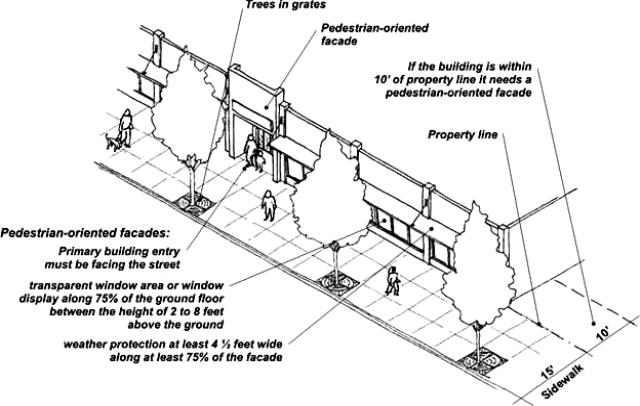
(B) No parking or drive-through aisles shall be allowed between the buildings and the street fronting arterials in the CB and TC Zones. Drive-through aisles that are visible from arterials shall be screened from view from the arterial. Screening shall be completed by installing a three-foot-high berm with landscape screening which will provide approximately 75 percent sight-obscuring screening four feet above the berm at maturity. Safe pedestrian access from the arterial sidewalk to building front doors shall be provided.
(C) For developments in the NB, RLTC and REC Zones, where a parking lot with more than two rows of parking, or equivalent depth of parking, is shown between the building and the arterial street (see Figures 3 and 4 for illustrations), one of the two landscape buffers below shall be provided:
(1) A 20-foot-wide landscape buffer planted per the following:
(a) Trees at an average rate of one tree per 30 lineal feet of street frontage. Permitted tree species are those that reach a mature height of at least 35 feet. To increase visibility, the trees can be clustered and/or staggered. A 30-foot break in the required tree coverage is permitted adjacent to permitted signage. In areas with limited space, a modular system that provides adequate soil volume for tree growth shall be considered.
(b) Shrubs at a rate of one shrub per 20 square feet of landscaped area. Shrubs shall be at least 16 inches tall at planting and have a mature height between three and four feet.
(c) Groundcover shall be planted in sufficient quantities to provide at least 70 percent coverage of the landscaped area within three years of installation.
Figure 3. Site plan illustrating the 20-foot landscaped buffer between large parking lots and arterial streets.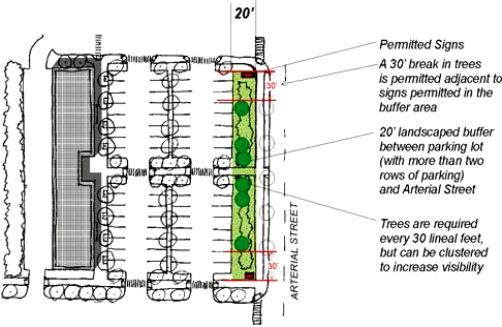
Figure 4. Sketch illustrating the 20-foot landscaped buffer between large parking lots and arterial streets.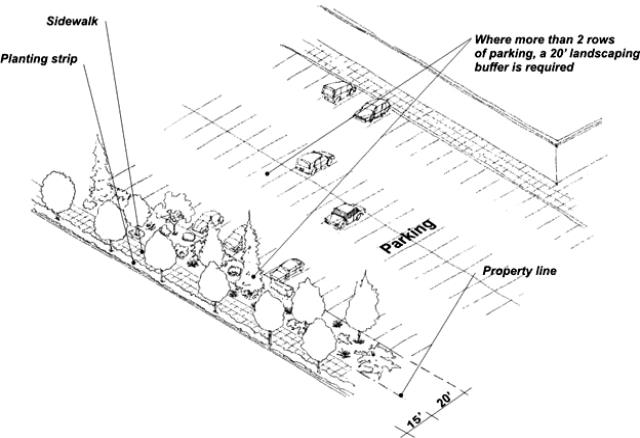
(2) A 15-foot landscape buffer with a three-foot-high berm provided within the buffer area. Trees, shrubs and groundcover requirements are the same as in subsection (B)(3)(a)(i)(C)(1) of this section. See Figure 5 for illustration.
Figure 5. The landscape buffer between parking lots and arterial streets may be reduced to 15 feet if a three-foot-tall berm is provided.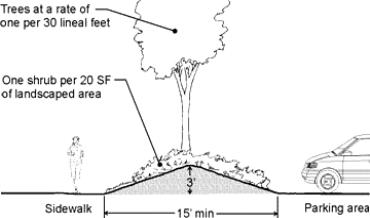
(D) Where buildings in the NB, RLTC and REC Zones have two or less rows of parking between them and the street frontage, a 10-foot buffer of Type III landscaping is required between the street and the parking area (see Figure 6 for illustration). Type III landscaping requirements are defined in MVMC 18.40.130.
Figure 6. Illustrating the requirement for a 10-foot buffer of Type III landscaping between the street and a parking lot featuring no more than two rows of parking.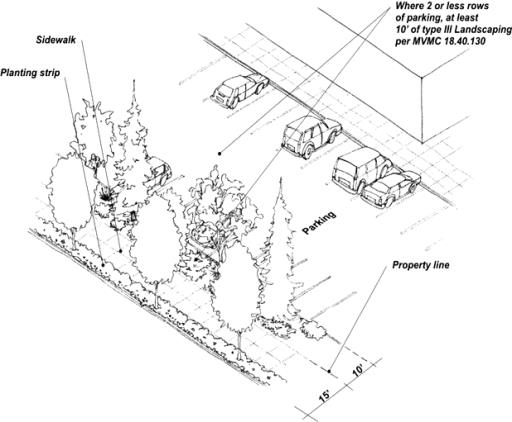
Figure 7. Illustrating the requirement for a 10-foot buffer of Type III landscaping between the street and any building that does not contain a pedestrian-oriented building facade facing the street.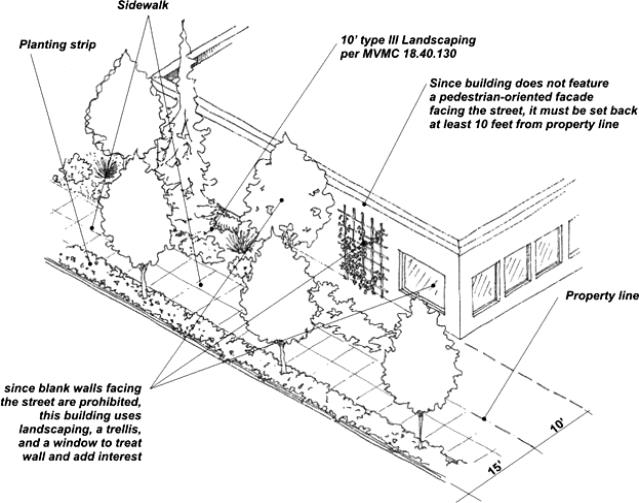
(E) The 10-foot buffer of Type III landscaping described in MVMC 18.40.130 is also required between the street and any building that does not contain a pedestrian-oriented building facade facing the street (see Figure 7 for illustration).
(F) Building entries must have direct access to the public sidewalk (entries may be on the side of buildings and connected by a pedestrian pathway).
(G) If the public sidewalk is less than eight feet wide, set the building back sufficiently to provide at least eight feet of uninterrupted walking surface.
b. Business Access Streets. These are all other commercial streets that are public and not classified as arterials. These are local streets for adjacent commercial and business use and access. These streets carry less traffic, may have on-street parking and are typically important pedestrian routes.
i. Development fronting on business access streets must conform to Table 1 and the requirements below unless the Director determines that they prevent a viable site development.
(A) If the public sidewalk is less than eight feet wide, set the building back sufficiently to provide at least eight feet of uninterrupted walking surface.
(B) Buildings in the CB, NB, TC, RLTC and REC Zones can be located within 10 feet of the street right-of-way if they present a “pedestrian-oriented building facade” to the street (see Figure 2 for illustration).
(C) For developments in the CB, NB, TC, RLTC and REC Zones, where a parking lot with more than two rows of parking, or equivalent depth of parking, is shown between the building and the business access street, one of the two landscape buffers detailed in subsection (B)(3)(a)(i)(C) of this section shall be provided (see Figures 3 through 5 for illustrations).
(D) Where buildings in the CB, NB, TC, RLTC and REC Zones have two or less rows of parking between them and the street frontage, a 10-foot buffer of Type III landscaping is required between the street and the parking area (see Figures 6 and 8 for illustrations).
(E) A 10-foot buffer of Type III landscaping described in MVMC 18.40.130 is also required between the street and any building in the CB, NB, TC, RLTC and REC Zones that does not contain a pedestrian-oriented building facade facing the street (see Figure 7 for illustration).
ii. Where properties are adjacent to more than one street, refer to Table 1 for requirements or preferences depending upon applicable zoning.
Figure 8. Illustrating the building/sidewalk relationship requirements of business access streets.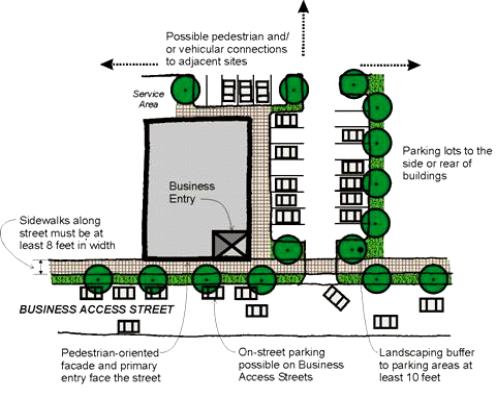
c. Business Connectors. These are not streets in the technical sense, but are important cross connectors from one business to the next for vehicles and pedestrians. They may connect parking areas for businesses and in some cases provide access or sole access to a tenant or tenants.
i. Development fronting on a business connector must conform to Table 1 and the requirements below unless the Director determines that they prevent a viable site development. Additional requirements:
(A) Buildings can be located within 10 feet of the street if they present a “pedestrian-oriented building facade” to the street. To qualify for this option, only “pedestrian-oriented space” or landscaping can be placed between the building and the street.
(B) If parking is desired between the building and the business connector, a buffer at least six feet in width of Type IV landscaping as required in MVMC 18.40.130 is needed.
(C) Developments shall provide pedestrian walkways on at least one side of the connector.
(D) Developments shall provide safe pedestrian access across the connector at least every 150 feet and be coordinated with required parking lot pathways.
(E) Developments shall provide street trees on both sides of the connector.
(F) Parallel, angled, or perpendicular parking is permitted on one or both sides of the connector.
(G) All buildings fronting on a business connector road in CB, NB, TC, RLTC and REC Zones with facades longer than 100 feet shall provide a minimum 12-foot walkway along the primary facade of the building(s). The walkway shall include an eight-foot minimum unobstructed walking surface and street trees per MVMC 18.40.130 placed no more than 30 feet on center. As an alternative to some of the required street trees, developments can provide pedestrian-scaled light fixtures at the same spacing and no taller than 14 feet in height. However, no less than one tree per 60 lineal feet of the required 12-foot walkway shall be required. To increase business visibility and accessibility, the Director will allow breaks in the required tree coverage adjacent to major building entries.
(H) Where properties are adjacent to more than one street, refer to Table 1 for requirements or preferences depending upon applicable zoning.
Figure 9. Illustrating the building/sidewalk relationship requirements of business connector roads.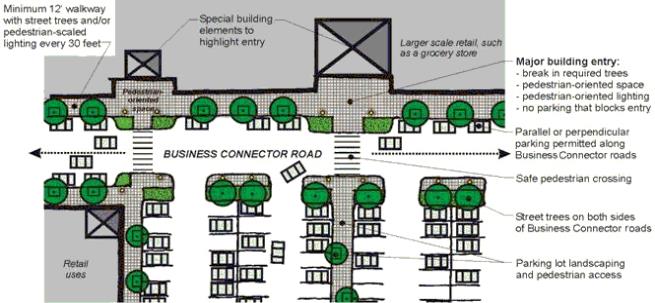
4. Multifamily Development and Building/Sidewalk Relationship Standards.
a. All multifamily developments shall adhere to the following standards unless the Director determines that they prevent viable site development. Where multifamily developments front on a designated arterial street, business access street or business connector, they must also meet those requirements as provided in Table 1 and subsection (B)(3) of this section, Street Types and Building/Sidewalk Relationship Standards. If there is a conflict between any requirements or standards, the Director shall decide which requirements or standards apply.
i. Parking areas should be located behind or under buildings and accessed from alley-type driveways. No more than 30 percent of the street frontage shall be occupied by parking lots. If parking is provided under the building, habitable building space shall be provided where the building fronts the sidewalk. If driveway access from streets is necessary, minimum-width driveways meeting the fire access standards shall be used.
ii. Locate parking lots so that they do not impose on the ground floor units’ privacy. If this is not feasible, locate buildings so they are far enough apart that adequate landscaping can be planted to provide privacy.
iii. Each building shall have direct pedestrian access from the main street fronting the building and from the back where the parking is located.
iv. Another alternative may be to orient the buildings into U-shaped courtyards where the front door/main entry into the building is from a front courtyard. Access to the courtyard from the rear parking area shall be through a well lighted breezeway or stairway. This alternative will work where projects abut an arterial or major collector street where the quality of living could be enhanced with buildings facing into the courtyard. The buildings would still be located between the street and the parking lot.
v. Front and side yards which abut a street shall be visually open to the street. Where fences or walls are necessary to reduce noise, provide buffers, create private yards or provide security, provide one or more of the following options to maintain a pedestrian scale along the street:
(A) Provide art (mosaic, mural, decorative masonry pattern, sculpture, relief, etc.) over at least 50 percent of the blank wall surface.
(B) Employ small setbacks, indentations, stepped fence heights, or other means of breaking up the wall or fence surface and height.
(C) Employ different textures, colors, or materials (including landscape materials) to break up the wall’s surface.
(D) Provide special lighting, a horizontal trellis, or other pedestrian-oriented feature that breaks up the size of the blank wall’s surface and adds visual interest.
vi. If fencing is required, repeat the use of building facade materials on fence columns and/or stringers.
C. Site Planning – Relationship to Surrounding Properties and Uses.
1. Goal. Enhance connectivity between uses, when desirable and practical. New development should be sensitive to adjacent uses. Protect and enhance a wooded character.
2. Standards and Requirements.
a. Developments shall provide landscaping buffers per Table 2 and MVMC 18.40.130 to minimize visual impacts of incompatible uses. Where substantial existing vegetation is in place in the required buffer areas, the Director may waive the required landscaping as long as the existing vegetation achieves site planning goals.
b. Developments shall retain significant trees per MVMC 18.40.130 to retain the wooded character and emphasize a natural setting.
c. Developments shall be configured to enhance vehicular and pedestrian connections between compatible uses per subsection (A) of this section, Site Planning – Connectivity.
|
|
|
Zoning of Applicable Property (Buffer Must Occur Within) |
||
|---|---|---|---|---|
|
|
|
CB/TC/NB |
REC/RLTC |
R-8 to R-24 |
|
Zoning of Adjacent Property |
CB/TC/NB |
– |
10-foot buffer Type III |
10-foot buffer Type III |
|
REC/RLTC |
– |
– |
10-foot buffer Type III |
|
|
R-8 to R-24 |
20-foot buffer Type I |
25-foot buffer Type I |
10-foot buffer Type III |
|
|
PRO(2) |
10-foot buffer Type III |
20-foot buffer Type II |
10-foot buffer Type III |
|
|
R-1 to R-6 |
20-foot buffer Type I |
25-foot buffer Type I |
10-foot buffer Type I |
|
Notes: (1) Landscaping types are defined in MVMC 18.40.130.
(2) Nonresidential developments in the PRO or R zones must use the above standards applicable to the R-8 zone or those standards established through the Conditional Use Permit, whichever are greater.
(3) CB/TC/NB zones abutting residentially zoned properties which have a vertical final grade change greater than 10 feet within 50 feet of the property line may be subject to increased planting and visual screening standards as determined by the Community Development Director.
D. Site Planning – Pedestrian Elements.
1. Goal. To improve the pedestrian environment by making it easier, safer and more comfortable to walk between businesses, to the street sidewalk, to transit stops, and through parking lots. Pedestrian facilities such as sidewalks, crosswalks and bus shelters should connect all modes of transportation. Provide the pedestrian, disabled person and transit user with a safe and clear path to the entry door of a building and maintain safe pedestrian routes across busy streets by a variety of means, including signalized intersections at cross streets and distinctively marked crosswalks where feasible. Provide safe and continuous pedestrian access in commercial areas making them more accessible and convenient by allowing people to walk between businesses and to safely walk and bike to commercial nodes from adjacent residential areas. Use the architectural elements of a building and landscaping to highlight and define the entrance, enhance the visual character of buildings, and improve the pedestrian environment.
2. General Pedestrian Access – Standards and Requirements. All pedestrian walkways must correspond with federal, State and local codes for barrier-free access, and the Americans with Disabilities Act. Excluded from this requirement would be trails in on-site greenbelts or undeveloped natural areas.
3. On-Site Pedestrian Circulation – Standards and Requirements.
a. Provide pedestrian pathways per Table 3.
|
Pedestrian Pathways |
Unobstructed Width |
Applicable Code Section(s) for More Pathway Details |
Landscaping and Design Features and Applicable Code Section(s) |
|---|---|---|---|
|
Arterials |
8 feet |
MVMC 18.70.030(B)(3)(a), Arterial Streets |
7-foot planting strip or street trees in grates between street and sidewalk |
|
Business Collector Streets |
8 feet |
MVMC 18.70.030(B)(3)(b), Business Access Streets |
7-foot planting strip or street trees in grates, where possible, between street and sidewalk. A modular system that provides adequate soil volume for tree growth shall be considered. |
|
Local Access Streets |
8 feet(1) |
MVMC 18.70.030(B)(3)(c), Business Connectors |
Trees, shrubs, and groundcover per MVMC 18.40.130, particularly in subsection (G), Parking Lot Landscaping |
|
Walkways along the primary facades of buildings longer than 100 feet in the CB/TC/NB/REC/RLTC zones |
8 feet |
MVMC 18.70.030(D)(3)(e), pedestrian elements |
Street trees in grates |
|
Walkways along the primary facades of buildings less than 100 feet in the CB/TC/NB/REC/RLTC zones |
6 feet(2) |
MVMC 18.70.035(G), blank walls |
Trees, shrubs, and groundcover per MVMC 18.40.130 and 18.70.035(G), blank walls |
|
Pathways to building entries from street |
8 feet(1) |
MVMC 18.70.030(D)(3)(b), pedestrian elements |
Trees and shrubs; also see MVMC 18.40.130(G), Parking Lot Landscaping |
|
Pathways through parking lots (required every 150 feet) |
8 feet |
MVMC 18.70.030(D)(3)(d), pedestrian elements |
Trees, shrubs, and groundcover per MVMC 18.40.130, particularly in subsection (G), Parking Lot Landscaping |
|
Pathways connecting buildings within individual development |
8 feet(1) |
MVMC 18.70.030(D)(3)(c), pedestrian elements |
Trees, shrubs, and groundcover per MVMC 18.40.130, particularly in subsection (G), Parking Lot Landscaping |
|
Pathways connecting compatible developments on different sites |
6 feet(1) |
MVMC 18.70.030(D)(5), pedestrian paths to adjacent uses and transit facilities |
Trees, shrubs, and groundcover per MVMC 18.40.130, particularly in subsection (G), Parking Lot Landscaping |
|
Pathway connecting from business or multifamily to trail |
6 feet(1) |
MVMC 18.70.030(D)(5), pedestrian paths to adjacent uses and transit facilities |
Trees, shrubs, and groundcover per MVMC 18.40.130 |
Notes: (1) The Director may require wider pathways where significant pathway use is anticipated. An eight-foot pathway, which accommodates three persons walking abreast, will be required for major routes. Pathways that are expected to accommodate more than 1,000 persons per hour should be at least 12 feet in width.
(2) The Director may allow landscaped areas in place of the walkway where it is demonstrated that a walkway along the facade is not necessary.
b. Provide paved pedestrian path from the street sidewalk to the main entry of all buildings. Where a use fronts two streets, access shall be provided from the road closest to the main entrance, preferably from both streets. Buildings with entries not facing the street should have a clear and obvious pedestrian accessway from the street to the entry.
c. Provide pedestrian paths or walkways connecting all businesses and the entries of multiple commercial buildings frequented by the public on the same development site.
d. Provide pathways through parking lots. Provide a walkway or sidewalk that is either paved or constructed with permeable materials through parking lots greater than 150 feet long (measured either parallel or perpendicular to the street front). Walkways shall be provided every four parking rows and a distance of less than 150 feet shall be maintained between paths. Such access routes through parking areas shall be separated from vehicular parking and travel lanes by use of contrasting paving material which may be raised above the vehicular pavement. Speed bumps may not be used to satisfy this requirement.
e. All applicable buildings in the CB, TC, NB, REC and RLTC zones with facades longer than 100 feet and not located adjacent to a public street must provide a minimum 12-foot walkway along the primary facades of all buildings. The walkway shall include an eight-foot minimum unobstructed walking surface and street trees per MVMC 18.40.130 placed no more than 30 feet on center. As an alternative to some of the required street trees, developments can provide pedestrian-scaled light fixtures at the same spacing and no taller than 14 feet in height. However, no less than one tree per 60 lineal feet of the required 12-foot walkway shall be required. To increase business visibility and accessibility, the Director will allow breaks in the required tree coverage adjacent to major building entries.
f. Access and stacking lanes for drive-through services and/or drop-off areas shall not pass over required or designated sidewalks or pedestrian paths or walkways.
Figure 10. Illustrating the required walkway along the primary facades of buildings in the CB, TC, NB, REC and RLTC zones with building facades longer than 100 feet.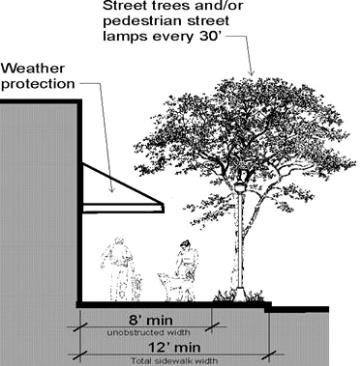
4. Pedestrian Amenities – Standards and Requirements.
a. All nonresidential development, excluding Business Park developments, shall provide at least one of the following pedestrian amenities near the sidewalk or required walkway:
i. Pedestrian furniture such as seating space, drinking fountains, and decorative garbage receptacles.
ii. Perimeter landscaping in addition to that required in MVMC 18.40.130.
iii. Artwork.
iv. Space for covered transit stop with seating.
v. Special window display areas consisting of a minimum 25 percent of the required window area of the front facade.
vi. Decorative screen wall, trellis or other building or site feature.
vii. Other element that encourages pedestrian activities as approved by the Director.
b. Provide pedestrian weather protection.
i. All development in the CB, TC, REC, RLTC and NB districts shall provide pedestrian weather protection at least four and one-half feet wide along 75 percent of the building’s front face where a pedestrian walkway is present. The weather protection may be in the form of awnings, marquees, canopies or building overhangs.
ii. Canopies or awnings shall not be higher than 15 feet above the ground elevation at the highest point nor lower than eight feet at the lowest point.
iii. The color, material and configuration of the pedestrian coverings shall be as approved by the Director. Coverings with visible corrugated metal or corrugated fiberglass are not permitted. Fabric and rigid metal awnings are acceptable if they meet the applicable standards. All lettering and graphics on pedestrian coverings must conform to the City of Maple Valley’s sign code.
5. Pedestrian Paths to Adjacent Uses and Transit Facilities – Standards and Requirements.
a. All developments shall provide interior automobile and pedestrian connections to adjacent properties per subsection (A) of this section, Site Planning – Connectivity.
b. Where possible, provide steps and ramps across retaining walls and slopes in accordance with Maple Valley City ordinances.
c. Gates should be provided to breach fences if they impede pedestrian movement to shopping and other common activities, including to transit.
d. Where a fence, wall or landscaped area separates a sidewalk from a multifamily building or one multifamily development from another, pedestrian breaks and/or crossings shall be placed at frequent intervals.
e. Adjacent landscaping shall not block visibility to and from a path, especially where it approaches a roadway or driveway.
f. In consultation with the appropriate transit agency, where appropriate, integrate transit stops into the development of adjacent site improvements. This may be done by providing extra space for waiting areas, incorporating bus pull-outs or stops into the site’s circulation scheme and/or providing a walkway (preferably covered) directly from the transit stop into the project’s entrance. Pavement for expanded waiting areas and connecting walkways may be located within required setbacks and may count as landscape areas. To act as an incentive, parking requirements may be reduced if convenient connections to transit are provided.
g. Encourage pedestrian paths from all transit stops through commercial areas to residential areas within 1,200 feet of the site.
h. Multifamily developers shall consult with the appropriate transit agency to determine whether the site is, will, or could be served by transit, and with the school district to see whether it is served by school bus. If the site is located on an existing or future transit or school bus route, the multifamily walkway network shall provide convenient pedestrian access to the nearest transit stop.
i. Easements for pedestrian access shall be recorded for the benefit of the City to facilitate the future extension of these paths as adjoining properties are improved.
6. Pedestrian Areas at Building Entries – Standards and Requirements.
a. Developments should avoid locating parking in such a way that interferes with visibility and access of major building entries.
b. The primary public entries of all buildings shall be enhanced by two or more of the following:
i. Provide at least 200 square feet of landscaping at or near the entry.
ii. Provide bicycle racks or pedestrian facilities, such as benches, kiosks, special paving, etc.
iii. Provide a trellis, canopy, porch, arbor or other building element that incorporates landscaping.
iv. Provide special pedestrian-scaled lighting.
v. Provide adjacent window displays.
vi. Provide building ornamentation such as mosaic tile, relief sculpture, ornamental wood or metal trim, etc.
vii. Provide artwork or special pedestrian-scaled signs.
E. Site Planning – Open Space Elements.
1. Goal. To provide a variety of pedestrian-oriented areas to attract shoppers to commercial areas and enrich the pedestrian environment. To create gathering spaces for the community. Provide usable open space in a multifamily development for all the residents of the development. (Refer to each zoning district for specific open space requirements.)
2. Standards and Requirements.
a. To qualify as a “pedestrian-oriented space,” an area must have:
i. Pedestrian access to the abutting structures from the street, connector or a nonvehicular courtyard.
ii. Paved walking surfaces of either concrete or approved unit paving.
iii. On-site or building-mounted lighting.
iv. At least three feet of seating area (bench, ledge, etc.) or one individual seat per 60 square feet of plaza area or open space.
b. The following features are encouraged in “pedestrian-oriented space” and may be required by the Director:
i. Spaces should be positioned in areas with significant pedestrian traffic to provide interest and security, such as adjacent to a building entry.
ii. Provide “pedestrian-oriented building facades” on some or all buildings facing the space.
iii. Movable seating.
c. The following features are prohibited within “pedestrian-oriented space”:
i. Asphalt or gravel pavement.
ii. Adjacent unscreened parking lots or parking areas not separated through the use of curbing, landscape areas, elevation, decorative walls or other components creating a physical separation.
iii. Adjacent chain link fences.
iv. Adjacent “blank walls.”
v. Adjacent dumpsters or service areas.
vi. Outdoor storage or retail sales that do not contribute to the pedestrian environment.
d. All developments in the CB, TC, NB, REC and RLTC districts must provide “pedestrian-oriented space” per Table 4. For the purposes of this section, all required walkways per Table 3, when applicable, shall not count as pedestrian-oriented space. However, the Director may allow those portions of walkways widened beyond minimum requirements to count towards the required pedestrian-oriented space as long as such space meets the definition of pedestrian-oriented space.
|
Building Footprint (square feet) |
Minimum Pedestrian-Oriented Space |
|---|---|
|
Less than 10,000 square feet |
1 square foot/100 square feet building footprint |
|
10,000 – 25,000 square feet |
1.25 square feet/100 square feet building footprint |
|
25,001 – 60,000 square feet |
1.5 square feet/100 square feet building footprint |
|
60,001 – 100,000 square feet |
1.75 square feet/100 square feet building footprint |
|
More than 100,000 square feet |
2 square feet/100 square feet building footprint |
e. Children’s play areas shall be clearly visible between and from the multifamily buildings.
f. Open spaces within multifamily developments shall connect with multifamily buildings, parking areas, and adjacent neighborhoods.
Figure 11. Illustrating pedestrian-oriented space standards and requirements.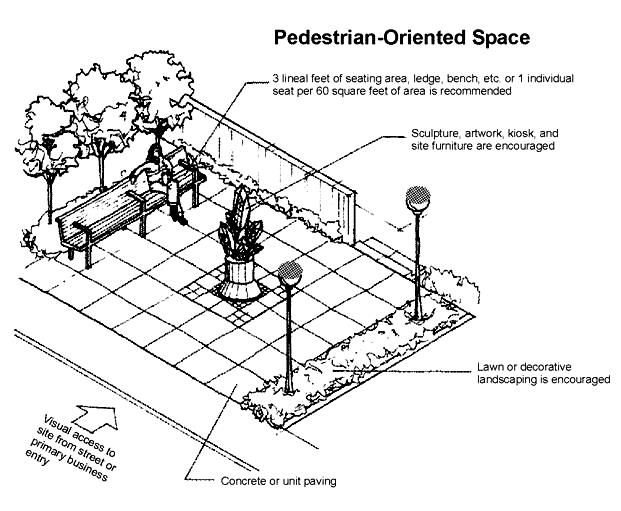
F. Site Planning – Street Corner Elements.
1. Goal. To enhance the appearance of highly visible sites. To upgrade the character and identity of Maple Valley.
2. Standards and Requirements.
a. All applicable development proposals for sites at street corners containing one or more arterial streets or two or more business collector streets must include at least one of the design treatments described below.
i. Locate a building towards the street corner (within 15 feet of the corner property line). Buildings located here must feature cropped or cut-out corners with “pedestrian-oriented building facades” and “pedestrian-oriented space.” Corner buildings are encouraged to include a special architectural element, such as a raised roofline, towers, or an extended parapet, along the most visible views of the structure.
ii. Provide a “pedestrian-oriented space” at the corner leading directly to a building entry or entries. The space may include a special architectural element such as a trellis to add identity or demarcation of the area.
iii. Install substantial landscaping (at least 30 feet by 30 feet or 900 square feet of ground surface area with trees, shrubs, and/or groundcover). The space may include a special architectural element such as a trellis to add identity or demarcation of the area. Such an architectural element may have a sign incorporated into it in addition to any other such signage permitted under MVMC 18.50.010 (as long as such sign does not identify an individual business or businesses).
Figure 12. Illustrating street corner options.
(Ord. O-23-790 § 1 (Exh. A); Ord. O-21-734 § 1; Ord. O-16-598 § 1(B) (Exh. B); Ord. O-14-564 § 7 (Exh. A); Ord. O-12-499 § 11; Ord. O-12-492 § 8; Ord. O-12-490 § 11; Ord. O-11-442 § 3; Ord. O-09-378 §§ 4, 5; Ord. O-05-304 § 4).
18.70.035 Building design standards and requirements.
A. Building Design – Vision.
1. Goal. To encourage buildings that complement their site and community’s environmental context. To encourage buildings that contribute to the wooded character of Maple Valley. To encourage buildings that enhance the pedestrian environment. To encourage modification of generic corporate architectural styles to conform with Maple Valley community design goals stated herein. To encourage buildings that contribute to the long-term economic vitality of Maple Valley.
2. Standards and Requirements.
a. Buildings shall provide architectural elements that emphasize building entries, incorporate design features that reduce their perceived architectural scale, incorporate appropriate details, and use high-quality and compatible materials.
b. Buildings shall blend their corporate or franchise architectural identities with the architectural vision of Maple Valley as expressed below.
c. Building placement on the site should take into account natural drainage patterns and control of stormwater runoff from building downspouts. Bioretention, rain gardens, downspout dispersion, downspout infiltration, and perforated stub-out connections shall be implemented where feasible. Other stormwater runoff control alternatives are encouraged and include rainwater harvesting, vegetated roofs, and minimum excavation foundations.
d. The images in Figures 13 through 19 illustrate characteristics desired for future buildings in Maple Valley.
Figure 13. This commercial building provides a highlighted entry, varied roof forms, attractive earth tone colors, use of varied materials, and the use of design details – all of which add visual interest to the building. (This building is located in Gig Harbor.)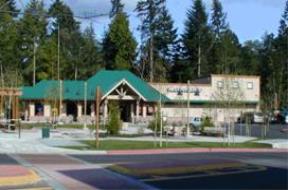
Figure 14. This existing Maple Valley commercial building provides a highlighted entry, varied roof forms, attractive colors, use of brick and other permanent building materials. 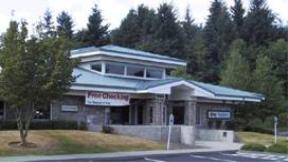
Figure 15. This commercial development provides pedestrian-friendly and varied building facades, use of modulated rooflines, use of varied materials and colors, weather protection features, and design details. (This building is located in Juanita, Kirkland.)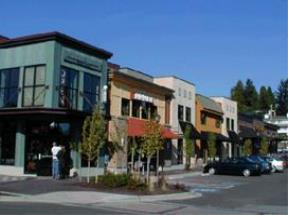
Figure 16. This commercial development is a good example due to its pedestrian-friendly outdoor spaces, attractive and varied storefronts, and small-scale design details. (This development is located in University Village.)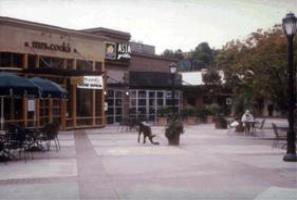
Figure 17. These commercial buildings are sited up to the streetfront with pedestrian-oriented facades and include varied building materials, rooflines, and color, and interesting design details. (This development is located in Snoqualmie Ridge.)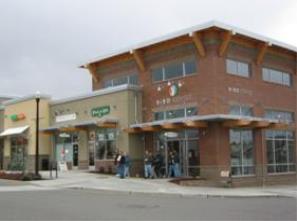
Figure 18. This multifamily development contains building modulation, articulation, and roofline and color variation to reduce the scale of the building and add visual interest. (This development is located in Snoqualmie Ridge.)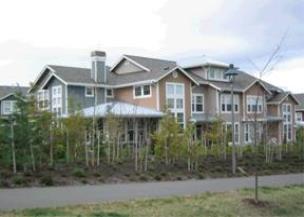
Figure 19. This business park development uses a highlighted entry with weather protection, windows, building modulation, and roofline variation in conjunction with landscaping to give the building a sense of integrity.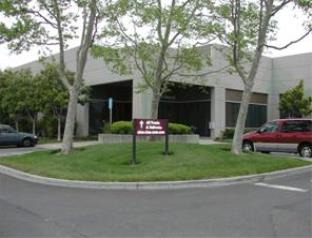
B. Building Design – Entry.
1. Goal. Use vertical architectural elements of a building to highlight and define the entrance. To enhance the visual character of buildings and to improve the pedestrian environment. Provide clearly defined multifamily building entries, which are well lighted and easily accessible and satisfy the Washington State Barrier Free Regulations.
2. Standards and Requirements.
a. Provide weather protection at least four and one-half feet wide over the primary entry of all buildings.
b. The entrances shall be plainly visible from the fronting street and/or walkway. The use of distinctive architectural elements and materials to denote prominent entrances will be encouraged.
c. Multifamily entries shall include a transition space from the sidewalks such as steps, a terrace, or a landscaped area.
d. If exterior stairways are used for multifamily entries, they shall be simple, clean, bold projections of stairways to fit with the architectural massing and form of the multifamily structure. Thin-looking, open metal, prefabricated stairs are discouraged.
Figure 20. Provide weather protection over all building entries.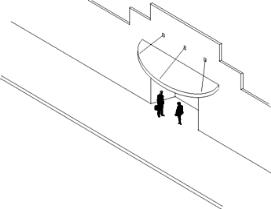
C. Building Design – Architectural Scale.
1. Goal. Encourage design features that reduce the apparent scale of large buildings and add visual interest to the development.
2. Standards and Requirements for Nonresidential Development. The standards and requirements below exclude business park developments involving buildings totaling less than 40,000 square feet in gross floor area.
a. Reduce the scale of buildings and add visual interest. All new buildings over one story, or over 5,000 square feet in gross building footprint or 100 feet in width, and visible from a street, parking area, or pedestrian route, shall provide building modulation and articulation as described below. Exception: facades not visible from a street, parking area, or pedestrian route are exempt or where demonstrated that other design treatments are sufficient to reduce the apparent scale of the building and add visual interest.
i. Building Modulation. Building modulation is the stepping back or projecting forward of portions of a building’s facade within the specified intervals of a building’s width and depth as a means of lessening the apparent bulk of a structure’s continuous exterior wall. All building facades shall conform to the following standards:
(A) The maximum width (as measured horizontally along the building’s exterior) without building modulation shall be 100 feet.
(B) The minimum depth of modulation shall be six feet or 0.2 multiplied by the height of the building, whichever is less.
(C) The minimum width of modulated components shall be 10 feet or equal to the required depth of the modulation, whichever is greater.
(D) Roof decks or balconies may be used as all or part of the building modulation so long as each individual balcony has a floor area of 100 square feet.
Figure 21. Building modulation requirement for nonresidential structures.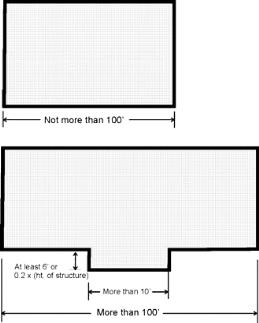
ii. Building Articulation. Provide building “articulation” with design elements such as the following, so long as the interval does not exceed 100 feet.
(A) Repeating distinctive window patterns at intervals equal to the articulation interval.
(B) Providing a porch, patio, deck, or covered entry for each interval.
(C) Changing the roofline by alternating dormers, stepped roofs, gables, or other roof elements to reinforce the modulation or articulation interval.
(D) Changing materials and/or color with a change in building plane.
(E) Providing a lighting fixture, trellis, tree or other landscape feature within each interval.
Figure 22. Building articulation.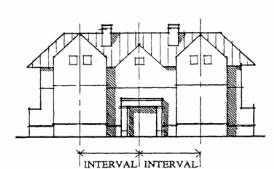
b. Single-use buildings in CB zones over 40,000 square feet in gross building footprint shall cluster smaller uses and activities around their primary entrances.
Figure 23. An example of clustering smaller uses and activities around the primary entrance of larger buildings.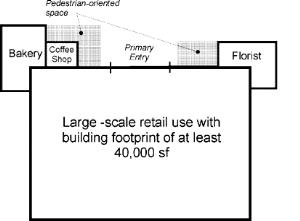
3. Vertical Mixed-Use Standards and Requirements.
a. Buildings shall comply with all requirements of MVMC 18.70.030, for nonresidential development, in addition to the standards and requirements below.
b. Buildings shall avoid long, monotonous, uninterrupted walls or roof planes. Buildings shall use articulation and/or modulation on all walls that are visible to pedestrians.
c. Mixed-use buildings with residential uses on upper floors shall use articulation and/or wall modulation along facades visible to pedestrians based on the width of individual dwelling units and/or rooms within the building. Levels two and above must employ a minimum 10-foot stepback, measured from the facade of the ground floor.
d. Buildings are encouraged to utilize vertical and horizontal relief in the facade that identifies a bottom, middle and top of the building.
e. Other design techniques that can be used to minimize the apparent size of the building:
i. Curved or articulated surfaces;
ii. Recessed entries;
iii. Roof lines, pitches and shapes;
iv. Cornices;
v. Building ornamentation;
vi. Overhangs and soffits;
vii. Dormers, balconies and porches that clearly define street-facing entries to residential properties;
viii. Building fenestration and detailing (storefront or multipaned windows for residential units); and
ix. Awnings and marquees.
4. Multifamily Standards and Requirements.
a. Developments should use wall plane articulation/modulation to break a multifamily building into house-size building elements when adjacent to single-family residential development.
b. Reduce the scale of buildings by using articulation and/or modulation at least every 30 feet. Options include:
i. Facade modulation, stepping back or extending forward a portion of the facade at least two feet (measured perpendicular to the front facade) for each interval.
ii. Articulating each interval with architectural elements like a porch, balcony, bay window and/or covered entry.
iii. Articulating the roofline by stepping the roof and by emphasizing dormers, chimneys, gables.
iv. Providing a ground- or wall-mounted light fixture, a trellis, a tree, or other site feature within each interval.
Figure 24. This multifamily development employs a variety of elements to reduce the architectural scale and add visual interest.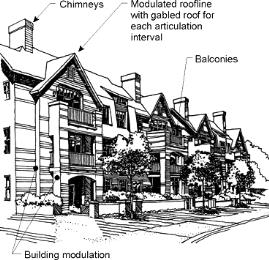
c. The maximum facade width (the facade includes the apparent width of the structure facing the street and includes required modulation) is 120 feet. Buildings exceeding 120 feet in width along the street front shall be divided by a minimum modulation of a horizontal width at least equal to 50 percent of the horizontal width of the primary building of the exterior wall, so that the maximum horizontal length of a particular facade is 120 feet. Such modulation must be at least 20 feet or deeper and extend through all floors.
Figure 25. Maximum facade widths.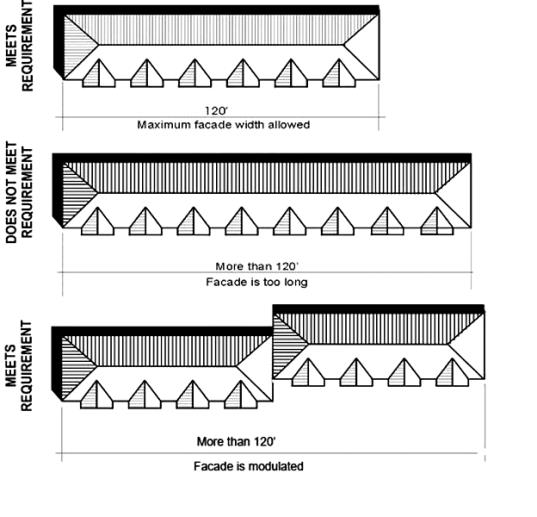
D. Building Design – Details.
1. Goal. Ensure that buildings are interesting at all observable distances. Encourage buildings that are comfortable by relating building elements to the size of the human body.
2. Nonresidential Standards and Requirements. All buildings shall include on the facades that are visible from a street, parking area, or pedestrian route at least three of the following:
a. Decorative rooflines such as an ornamental molding, or other roofline device visible from the ground level. If the roofline decoration is in the form of a linear molding or board, then the vertical width must be at least eight inches wide.
b. Decorative treatment of windows and doors, such as decorative moldings, framing details, decorative glazings, or door designs, around all ground floor windows or doors located on facades facing or adjacent to public streets or parks.
c. Decorative railings, grillwork or landscape guards.
d. Landscaped trellises and arbors.
e. Decorative light fixtures with a diffuse visible light source such as a globe or “acorn” that is nonglaring or a decorative shade or mounting.
f. Decorative building materials, including the following:
i. Decorative masonry, shingle, brick or stone.
ii. Individualized patterns or continuous wood details such as fancy butt shingles in a geometric pattern, decorative moldings, brackets, wave trim or lattice work, ceramic tile, stone, glass block, Carrera glass, or similar materials.
iii. Other materials with decorative or textural qualities.
g. Decorative paving or artwork. The artwork may be freestanding or attached to the building, and may be in the form of mosaic mural, bas-relief sculpture, light sculpture, water sculpture, fountain, freestanding sculpture, art in pavement or other similar artwork. Painted murals or graphics on signs or awnings do not qualify. Avoid the use of building features or design elements which overemphasize corporate themes, or logos, or colors which stand above the community context without adding functional or aesthetic value to the building context.
h. Carved wooden signs.
Figure 26. Building details.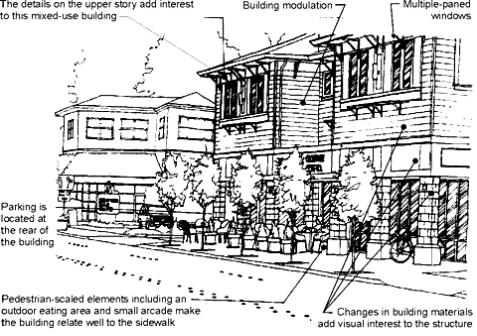
E. Building Design – Roof Forms.
1. Goal. To reduce the perceived scale of large buildings and add visual interest.
2. Standards and Requirements.
a. Modulate the roofline of all facades visible from a street, parking area or pedestrian route according to one or more of the following:
i. Provide a gable, hipped or shed roof with a slope of at least four feet vertical to 12 feet horizontal. The individual segments of the roofline must not extend more than 100 feet in width (measured horizontally).
ii. Roofline modulation of flat roofs with horizontal eaves, fascia, or parapets. The width of a continuous flat roofline shall extend no more than 100 feet without modulation. No freestanding building with a flat roof shall be without modulation. Modulation shall consist of either:
(A) A change in elevation of the roofline visible from a street, parking area or pedestrian route of at least four feet if the particular roof segment is less than 50 feet wide and at least six feet if the particular roof segment is greater than 50 feet in length.
(B) A sloped or gabled roofline segment of at least 20 feet in width and no less than four feet vertical in 12 feet horizontal.
(C) A combination of subsections (E)(2)(a)(ii)(A) and (B) of this section.
3. Evaluation of vegetated roofs is encouraged for roof slopes between five and 20 degrees and must be designed according to the Low Impact Development Technical Guidance Manual for Puget Sound.
Figure 27. Illustrating roof modulation standards.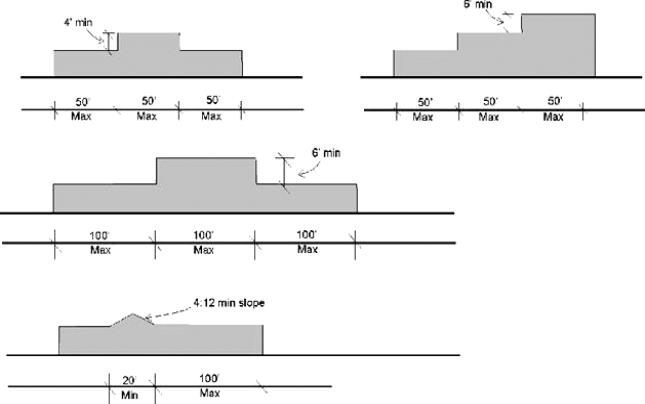
a. Coordinate modulation of rooflines to emphasize key building entries and/or change in building tenants or uses.
b. Use roof modulation in multifamily buildings that employ:
i. Gable, gambrel or hipped roof;
ii. Broken or articulated roofline;
iii. Prominent cornice or fascia that emphasizes the top of the building;
iv. Other roof element that emphasizes a building’s concept and helps it to fit in with neighboring structures with prominent roofs.
F. Building Design – Building Materials and Color.
1. Goal. Encourage the use of high-quality, compatible materials that enhance the visual qualities of multifamily, commercial and other applicable nonresidential areas within Maple Valley’s built environment. These include materials that have texture, pattern, or lend themselves to a high level of quality and detailing. Use exterior colors that emphasize earth tones that are subdued, especially on large walls and buildings. Use building exterior materials which are durable, easily maintained and attractive even when viewed up close.
2. Standards and Requirements. The selection and use of exterior materials is a key ingredient in determining how a building will look. Some materials, by their nature, can give a sense of permanence or can provide texture or scale that helps new buildings fit better in their surroundings.
a. Materials could include clear/painted wood siding, shingles, brick, stone, stucco, ceramic or terra cotta tile. Use of a combination of materials is encouraged, particularly when coordinated with building modulation components or to emphasize the building entry or change in building tenants.
b. Use compatible building materials.
i. Detail Requirements for Metal Siding. If metal is used as a siding material of a building’s facade, the metal siding must have a matte finish and include the following elements:
(A) Visible window and door trim painted or finished in a similarly subdued color that highlights the window and door detailing.
(B) Corner and edge trim that cover exposed edges of the sheet metal panels.
(C) If a building has metal siding covering more than 50 percent of any facade visible from a street, parking area, or pedestrian route, it shall not have a metal roof.
ii. Requirements for Concrete Block Walls. If concrete blocks (concrete masonry units or “cinder blocks”) are used for walls that are visible from a street, parking area, or pedestrian route, then the concrete block construction must be architecturally treated in one or more of the following ways:
(A) Use of textured blocks with surfaces such as split-face or grooved.
(B) Use of other masonry types such as brick, glass block, stone or tile in conjunction with concrete blocks.
(C) Use of decorative coursing to break up large blank walls.
iii. Prohibited Materials. The following materials are prohibited in visible locations unless an exception is granted by the Director:
(A) Highly reflective or mirrored glass covering more than 10 percent of the building exterior or in any amount that may pose a hazard.
(B) Corrugated fiberglass and similar materials.
(C) Crushed, colored rock/ glass slag.
(D) Textured or scored plywood or similar materials.
iv. Chain link fencing (except for temporary purposes such as a construction site) along any street frontage shall have a minimum three-foot-deep area to be planted in such a way as to camouflage and/or screen the fencing. Where used, chain link fences should be vinyl-coated and black or green in color. The use of razor wire is prohibited.
c. All sides of buildings visible from a street, parking area, or pedestrian route shall be finished with the visually compatible material and color scheme. All sides of residential buildings must be finished with the same material and color scheme.
d. When remodeling or adding onto an existing building, use materials and a color scheme that complement or enhance the quality of the original building.
e. On larger buildings, use colors to visually reduce the size of the buildings.
f. Use acceptable building colors, specifically:
i. Acceptable colors for the basic building shell (at least 70 percent of the building shell, excluding the roof, that is visible from a street, parking area, or pedestrian route) include earth tones (brown, red-brown, tan, buff, ochre, gray, white, ivory, clear or lightly tinted glass, and unpainted natural materials such as wood, brick, or stone).
ii. Acceptable trim and secondary colors (one or a combination of the following colors may constitute up to 20 percent of the facade surfaces that are visible from a public right-of-way or parking area excluding glazing and roofs) include:
(A) Any of the basic building colors identified in subsection (F)(2)(f)(i) of this section;
(B) Dark saturated colors such as dark green, dark blue, dark red, barn red, deep blue-green, burnt orange, maroon, dark brown, and black.
iii. There are no restrictions on acceptable accent colors (accent colors shall not occupy more than 10 percent of any building facade visible from a public right-of-way or parking area).
iv. Buildings shall use trim and accent colors that contrast yet complement the basic building shell color.
v. Acceptable roof colors include:
(A) Dark saturated colors such as dark green, dark blue, dark red, barn red, maroon, burnt orange, deep blue-green, dark brown, dark gray, and black.
Figure 28. Illustrating the locations of basic building shell, trim, and accent colors.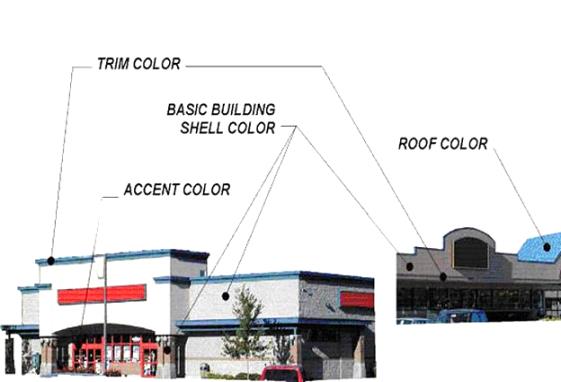
Figure 29. Illustrating acceptable colors for the building shell, trim, accent, and roof.
(See City site for color graphics: www.ci.maple-valley.wa.us.)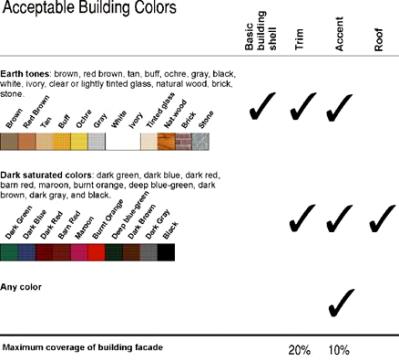
G. Commercial – Building Design – Blank Walls.
1. Goal. Reduce the visual impact of large, undifferentiated walls and reduce the apparent size of large blank walls through the use of various architectural and landscaping treatments. “Blank wall” means any building wall visible from a street, parking area or pedestrian route which is a portion of a building wall or facade that meets the following criteria:
a. Has a surface area of 400 square feet of vertical surface without a window, door, or building modulation or other architectural feature; and
b. Is over four feet in height from ground level and longer than 15 feet as measured horizontally without having a window, door, building modulation or other architectural feature.
2. Standards and requirements for all development except business park structures not visible from a street.
a. All blank walls visible from a street, parking area, or pedestrian route, or adjacent lot, shall be treated in one or more of the following ways:
b. Installing a vertical trellis in front of the wall. Optional plantings such as climbing vines or plant materials are encouraged.
c. Providing a landscaped planting bed at least five feet wide or raised planter bed at least five feet wide in front of the wall, and planting with plant materials that obscure or screen at least 50 percent of the wall’s surface within three years.
d. Providing artwork (mosaic, mural, sculpture, relief, etc., but excluding simple geometric patterns). All artwork shall be maintained in good condition by the property owner.
The City may waive the requirement for blank wall treatment where the requirement conflicts with the fire code regulations or will not serve a visual purpose.
Figure 30. Blank wall treatments.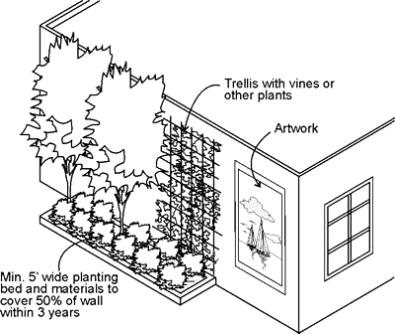
(Ord. O-21-734 § 1; Ord. O-16-598 § 1(B) (Exh. B); Ord. O-14-564 § 8 (Exh. A); Ord. O-10-415 § 4; Ord. O-05-304 § 4).
18.70.040 Auto-related business design standards.
A. Goal. Developments shall minimize the visual impacts on surrounding developments through appropriate design standards and requirements.
B. Standards and Requirements.
1. Retail fueling stations located in the REC and NB zones shall adhere to the design standards and requirements otherwise applicable to the CB zone.
2. Canopies for automobile fueling stations, storage and repair and maintenance businesses shall have a pitched roof that contains a slope of at least four feet vertical to 12 feet horizontal and no taller than 25 feet.
3. Internal and up-lit illumination of the canopy and pumps shall be prohibited. Lighting on the underside of the canopy shall be full cutoff, recessed into the canopy and shielded if required to prevent glare and light trespass. Signage conforming to Chapter 18.50 MVMC may be located on the canopy.
4. Commercial and retail fueling stations shall be limited to a maximum of six dispensers (12 fueling points). Liquid fuel storage tanks greater than 300 gallons in size must be enclosed within the structure or located underground. Propane and natural gas storage tanks may be located outside and above ground. All above-ground storage tanks shall be screened.
5. Automobile fueling stations, storage, repair and maintenance businesses with street frontage on streets designated as collectors and above should comply with CB landscape standards as specified in MVMC 18.40.130. (Ord. O-16-598 § 1(B) (Exh. B); Ord. O-12-492 § 9; Ord. O-05-304 § 4).
18.70.050 Reserved.
(Ord. O-16-598 § 1(B) (Exh. B); Ord. O-05-304 § 4).
18.70.060 Reserved.
(Ord. O-16-598 § 1(B) (Exh. B); Ord. O-05-304 § 4).
18.70.070 Neighborhood Business incentives.
Amenity incentives for the Neighborhood Business zone are listed in the chart below. The amenity incentive chart describes the gross floor area bonus offered by the City for specific amenities which provide a long-term public benefit. The incentives allow single uses in the NB zone to gain additional gross floor area (GFA) in excess of the 10,000-square-foot base limit, up to a maximum of 15,000 square feet. The incentives are for amenities in addition to the design requirements of the zone.
|
Table 5. Neighborhood Business Amenity Incentives. |
||
|---|---|---|
|
Amenity |
Gross Floor Area |
Design Criteria |
|
Artist-Made Materials, Artwork, Sculpture, Water Feature |
Up to 1,000 square feet |
10 square feet for every $100.00 of appraised value |
|
Significant Tree Canopy |
Up to 1,000 square feet |
200 square feet GFA for each 1% additional significant tree canopy coverage provided |
|
Landscaping |
Up to 1,000 square feet |
1 square foot GFA per 2 square feet of additional landscape area |
|
Bus Pull-Out/Shelter |
1,000 square feet (if not feasible, an additional 1,000 square feet GFA may be earned through POS Plaza incentive) |
Locate, design and construct bus pull-out lane or shelter meeting Maple Valley and KC Metro approval |
|
Pedestrian-Oriented Space (POS) |
Up to 1,000 square feet |
1 square foot of GFA for every square foot of POS. POS areas shall contain a minimum of one 4-bike rack |
|
Low Impact Development Facilities |
Up to 1,000 square feet |
Design according to the current King County Surface Water Design Manual. Incentive for LID facilities that are above and beyond the current requirements. |
(Ord. O-16-598 § 1(B) (Exh. B); Ord. O-05-304 § 4).


